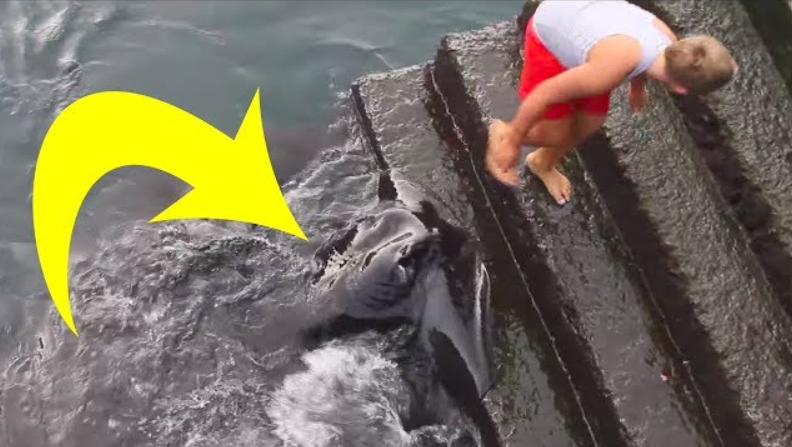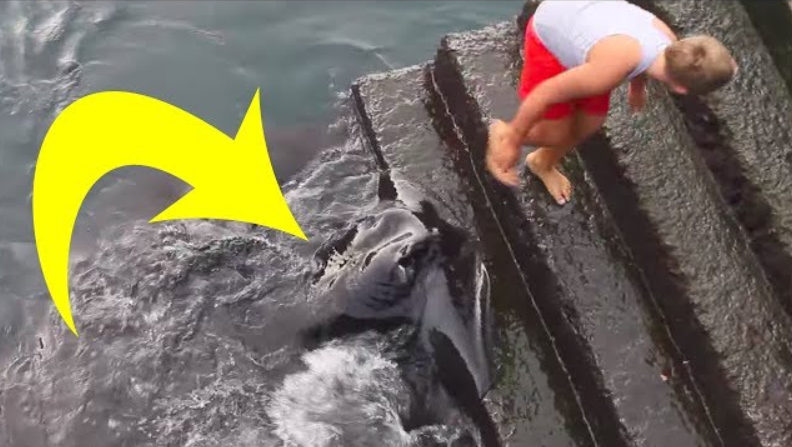This Boy Was Standing On The Water’s Edge When He Suddenly Felt Something Splash At His Feet

La Gomera is a Spanish Canary Island situated in the Atlantic Ocean, just off the African coast. It’s renowned for its pristine, untouched landscapes and draws visitors from near and far throughout the year.
The main tourist resort on the island is called Valle Gran Rey, which was once a haven for hippies. Today, all kinds of people visit the area, and the town’s biggest attraction is its beautiful beaches.

However, in recent years, the resort has become known for a rather peculiar attraction. In 2013, someone captured a strange spectacle on camera, which was then posted on YouTube. Over 50 million people have watched it, and it’s easy to see why viewers find the video mesmerizing.
The video begins with a little boy standing in the water at the edge of Valle Gran Rey harbor, seemingly trying to attract something. He starts splashing his hand in the waves, and before long, a giant fin arrives, sloshing at his feet.
Undeterred by the mysterious mass in the water, the little boy begins throwing fistfuls of food into the deep. As he does so, there’s a noticeable stirring in the ocean. Yes, as the unknown sea creature nears the shore, a number of fish dart out of the way to accommodate it.
After a while of quiet anticipation, the creature in question emerges from the water and drags itself off a ramp, coming within touching distance of the child. It’s only at this point in the video that viewers can make out what lies beneath the water’s surface.
The harbor visitor is, in fact, a gigantic manta ray. As it turns out, this ray is on the hunt for its next meal. However, the creature isn’t content to feed like other rays of its kind; instead, it wants the little boy Joel to place food directly into its mouth.
In unbelievable scenes, Joel can be seen hand-feeding the animal before giving it a reassuring stroke. Happy with its meal, the manta ray responds by giving the boy an appreciative wave of its fin. For a few minutes, the fascinating fish skulks around the harbor, returning regularly to Joel for a quick bite or a pet. It seems completely at ease in the company of humans.
At one point, the ray appears to try to get closer to Joel as it enjoys a stroke. However, it seems that the animal has places to be and soon departs the scene, leaving its little friend all alone on the seafront.
There is, however, a good chance that Joel and the manta ray will meet again. Tarifa, where this extraordinary scene took place, is still a popular fishing harbor. As a result, manta rays often follow boats into the harbor in hopes of feasting on their discarded bycatch.
In the past, sailors were superstitious about manta rays, believing that the creatures could sink boats by yanking on their anchors due to their size and power. However, in 1978, a group of divers in California began to interact with the creatures and revealed them to be very placid.
Since then, many people have formed bonds with these animals, just as Joel did. In recent years, numerous videos have emerged online showing humans interacting with manta rays in the ocean, with the majority depicting positive experiences.
One such video mirrors Joel’s experience. It was taken in the Maldives and shows a manta ray climbing a ramp to take food from excited tourists. After its meal, the ray sticks around, allowing onlookers to play with it.
Another video features a group of divers off the coast of Costa Rica. They encounter a giant stingray caught in a fishing net and promptly work to free it. This action highlights the threats posed to manta ray populations by fishing entanglement.
Sadly, conservationists now consider the species vulnerable to extinction. However, the animals’ online popularity may help their conservation status. Manta tourism is gaining popularity worldwide, raising both money for local economies and awareness of the creatures’ plight.
In 2014, Indonesia banned manta ray fishing after realizing that tourism was more profitable. While a dead manta ray could be sold for $500, manta ray tourism could generate a million dollars during its lifetime.
So, while Joel’s gesture might not seem significant at first, the more people who see manta rays as friends rather than foes, the better it is for everyone.




